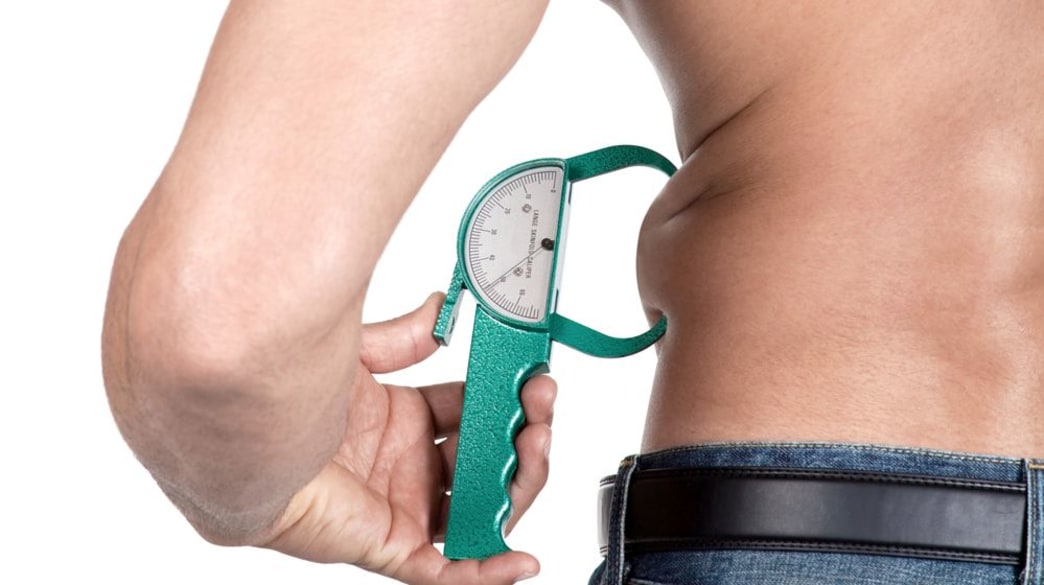
Don’t like feeling the pinch? There’s more than one way to measure your body fat percentage.
Apart from looking in the mirror, stepping on the scales remains the most common method people use for checking on the progress of their exercise regime. However, while weight is undoubtedly a useful measure of fitness for many people, it can also be misleading to judge the effects solely by what it says on the scales.
If you’ve been hammering away in the gym for weeks on end but the needle on the scales isn’t budging, it could well be because your body fat is being replaced with muscle mass. This could result in your overall weight staying static while your body composition changes for the better, making you healthier.
A high body fat percentage is linked with an increased risk of several common health issues, including heart disease, type 2 diabetes and some cancers. In contrast, a high muscle mass percentage is linked with looking ripped and an increased risk of Tinder matches.
RECOMMENDED: What Is A Healthy Body Fat Percentage?
Standard measurements like simple weight and BMI – which is calculated using weight and height – are useful, especially at a population level when formulating healthcare policies, but part of the reason they are so widely used is that they are relatively easy measurements to take, whereas in the past it has been hard for people to get access to their body composition stats.
Nowadays, however, there are several reliable ways to measurement your body fat percentage and muscle mass. Here are five methods of measuring your body fat, including three that can be done easily at home.
Calipers
The old-school method of measuring body fat, calipers are also the cheapest and easiest option available for everyday gym-goers. Using at least three spots on your body – chests, abs and thigh are good places to start – pinch the skin and measure the fold with the calipers. You then plug those numbers into a formula or, more conveniently, an online calculator which will give you your body fat percentage. You can pick up a set of calipers for under a fiver on amazon.co.uk.
Smart Scales
An increasingly common sight in bathrooms across the land, smart scales don’t just give your weight, but also a host of body composition stats including your body fat percentage. Many smart scales will also send all that info to your smartphone, so you can track trends over time.
RECOMMENDED: The Five Best Smart Scales To Track Your Body Composition
Handheld Scanner
The Skulpt Chisel scanner has one big advantage over smart scales when it comes to measuring fat – it can be moved around the body. That means you can get body fat percentage readings from up to 24 different muscle groups and, in theory, a more accurate overall reading than you get from simply standing on a scale. The Skulpt Chisel will set you back around £80 on amazon.co.uk.
Hydrostatic Weighing
Hydrostatic weighing takes the weight of a subject while submerged underwater. As fat tissue is less dense than water and lean tissue is denser than water, body fat percentage can be determined by the subject’s weight in the tank. Although considered the most accurate approach, hydrostatic weighing is rather expensive and impractical.
RECOMMENDED: How to Reduce Body Fat in 12 Easy Steps
DEXA
Dual-energy X-ray absorptiometry (DEXA) uses imaging technology to determine the weights of the bone mass, lean mass and fat tissue mass in the body. Like hydrostatic weighing, DEXA is extremely precise and very costly, but the extra accuracy it provides makes it especially valuable to elite athletes.
“Most professional athletes and teams undergo dedicated strength and conditioning to provide muscle and strength where it’s needed and to reduce overall body fat,” says Phil Chant, director of Bodyscan, a London-based company that provides the service.
“Accurate measurement with DEXA can gauge how players are responding to strength and conditioning regimes, and other training.”
“DEXA’s precision can also help coaches get injured players – who may lose muscle unevenly and gain overall body fat – back on the field more quickly, as well as even out muscle imbalances.”
An accurate scan can also shed light on physical problems pros might have that aren’t clear to the naked eye.
“Bodyscan once scanned a footballer who had recently been signed by a pro team and he had shockingly low muscle due to a diet of crisps and Irn-Bru,” says Chant.
“This wasn’t obvious just by looking at him, but with regular DEXA measurement the coach could get him to a body composition that would be a solid foundation for better performance.”
Amateurs may also benefit from the extra insight provided by DEXA, although we’d hope that you wouldn’t use it to check if your crisps and Irn-Bru diet is working (it isn’t).
“Most sports, especially endurance ones, require low levels of body fat and we can tell people how many kilos they need to lose to get to a better place,” says Chant.
“Muscle is harder to put on than fat is to lose but, unlike fat, you can target specific areas. Bodyscan will highlight how muscle is distributed around the body – for example, a cyclist will be happy with an uneven distribution that’s heavy in the legs and light in the arms.”
Having a firm grip on your body composition can also act as a motivation.
“Unlike professionals with coaches, amateurs have to inspire themselves, and DEXA’s precise data showing muscle going on and fat coming off – even when the scales and the mirror suggest they aren’t – is a very powerful motivator to stick with the programme or change direction if necessary.”
Written by Nick Harris-Fry for Coach and legally licensed through the Matcha publisher network. Please direct all licensing questions to legal@getmatcha.com.
Featured image provided by Coach

 Copyright © 2018 XR Nutrition.
Built with love in Utah
All rights reserved.
Copyright © 2018 XR Nutrition.
Built with love in Utah
All rights reserved.